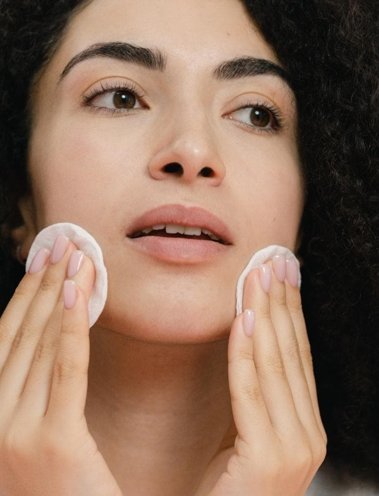Toner Vs Essence: What’s The Difference?

Within the skincare realm, toners have historically confused people – what do they do? When do you apply them? Nobody seems very sure. And to add to the confusion, essences (that look almost identical to toners), inspired by Korean beauty, became part of mainstream beauty a few years ago.
They both have runny, liquid textures; they come packaged in tall bottles, and most people (even those who use them) aren’t sure what either of them does.
It turns out they’re very different.
We asked Charlotte McHale, Clarins Training Manager, to help decode their functions.

The difference between a toner and an essence
To understand the differences between these products, it’s essential to learn about the components of a skincare routine.
“Irrespective of how many steps are in your routine, there are two main parts,” McHale explains. “Part one is taking stuff off your face and resetting the skin, and part two is about applying stuff on your face to help improve the skin.”
What's toner? Part one typically consists of the cleansing, exfoliating and toning steps. Cleansers remove makeup, oils and dirt. Exfoliators get rid of dead skin. And
Part two includes essences, serums, moisturisers and oils. All these products are meant to help target skin concerns and keep moisture locked in. But what is an essence? An
“As a general rule, it’s good to start applying the thinnest texture and work your way up to the thickest texture,” says McHale. “Which is why we start with essence and serum, followed by moisturiser and SPF.”
The confusion generally occurs because toners and essences sit next to each other in the routine.
Should you be using a toner?
When asked whether toner should be a non-negotiable step in everyone’s routine, McHale replies, “That depends on your skin type. If you have a ‘normal’ skin type that’s not dry, oily or dehydrated and is completely unproblematic, you probably don’t need to use a toner. But most of us don’t have ‘normal’ skin. Which is why most people can benefit from a toner.”
She explains that the process of cleansing can inflame certain skin conditions. For example, sometimes cleansing or exfoliating can cause redness if you’re sensitive or a feeling of tightness if you’re dry. Choosing the right toner for your skin type can help eliminate these unpleasant symptoms and make the products you apply work harder.
In addition, irrespective of your skin type, a good toner helps rebalance your skin’s pH, which helps maintain moisture and hydration levels.
The
If your skin is dry, reach for the
Essence vs Toner: Which one should you use?
Using just toner or essence, or using both? This depends on your skincare goals and skin type. If you have acne-prone skin, we recommend you use just toner. But if you have other skin concerns, such as hyper-pigmentation, an essence with ingredients like Vitamin C would work for you.
How to use essence & best face essence recommendations
Essence should be the first step in part two of your skincare routine after cleansing and toning. “Because it’s so thin, it can reach a deeper layer of the epidermis, where cell generation occurs,” says McHale.
This is why it’s great to target concerns like premature signs of ageing. “By reaching the deepest layer of the epidermis, essences ensure new cells get the right ingredients so that by the time they come to the surface, they’re in the best possible condition.”
After essence, you can follow up with your
For the best face essence, we recommend these products based on your skin condition.
The
If you are looking for a treatment essence to target dark spots,
“Essences are great if sluggishness, renewal or dehydration are things you want to target with your skincare,” says McHale. “If not, I wouldn’t necessarily call it an essential.”
It’s also important to acknowledge that skincare can be whatever you want it to be. If a quick, functional routine is what you prefer, keep it simple.
But if skincare translates into self-care, feel free to add as many steps as you like — toner, essence and all.
Shop related products
ONLINE EXCLUSIVE
Bright Plus Dark Spot Targeting Milky Essence
200 ml
A soothing, light textured treatment essence in a milk formula targeting dark spots for a visibly brighter, even complexion.
BEST SELLER
Multi-Active Day Revitalizing Treatment Essence
200 ml
Indulge in a fresh, sensorial niacinamide essence that revitalises, hydrates and moisturises the skin, leaving it looking and feeling smoother. The Clarins Multi Active Revitalizing Treatment Essence is the perfect addition to your skincare routine if you’re a busy, on-the-go woman in your 30s. The carefully curated ingredients by the experts at Clarins help to prevent the early signs of ageing skin whilst promoting a healthy and youthful glow.
